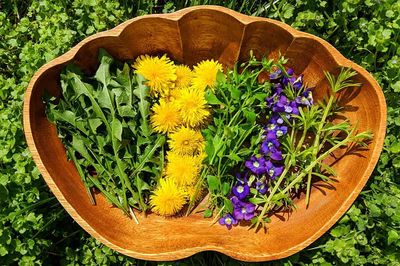Even though it's still winter, I am looking forward to spring. One of my happiest first signs of spring is the return of vibrant plant growth to my yard. Three of my favorites that I’d love to share with you are dandelions, violets, and chickweed. All three of these plants are simple to identify, have edible parts, and are a cornerstone of my herbal preparations. Back before we had year-round access to produce, these mineral-rich herbs were a welcome kickstart to our diets after a winter without fresh vegetables. They’re also easy to incorporate into your meals! Besides being free and tasty, these plants are often more nutritionally dense than the greens we can purchase at the grocery store.
NOTE: before you start foraging, always make sure you are 100% certain in your plant identification before eating something, and don’t eat anything from yards that have been sprayed.
Dandelion
When I forage the roots, I prefer to dig dandelion roots in the fall, when they have a higher level of inulin, but in spring their greens and flowers are absolutely delicious. The greens get more bitter as the leaves get larger, so you’ll want to harvest these when they’re young and tender. They’re a fun addition to your salads or can be dried as part of an herbal tea. The yellow ray florets of the flowerhead can be pulled off and added to your salads, as well. And let’s not forget about the joys of making dandelion wine!
Violet
Violets, with their bright purple flowers, are also simple to find in your yard. Both the leaves and the flowers are edible and are a fun way to jazz up salads (who doesn’t love edible flowers?).
The leaves can also be added to your soups and stews, or lightly sauteed with other vegetables. Violet leaves provide a good amount of soluble fiber as well as Vitamins A and C.
The flowers are quite versatile in the kitchen—they can be candied as a decoration for desserts, frozen into ice cubes to impress your guests the next time you host an event, or infused into a gorgeous purple-hued simple syrup. If you feel like getting adventurous and beginning to learn about some herbal preparations, violet leaves can also be infused into oils to make a cooling, soothing salve.
Chickweed
Chickweed, like violets, grows low to the ground in a dense carpet of greenery. Another name for it is starweed, due to its small white flowers. Each flower has five double-lobed petals, with the cleft so deep that it initially looks like ten petals. At this time of year, they are tiny stars of white that readily catch your eye in a sea of green. Both the greens and the flowers are edible, so you can forage with a pair of scissors, by giving chickweed a “haircut.” Come back a few days later, and you’re sure to see fresh growth.
I love chickweed in salads and sometimes even in smoothies (provided your blender can break everything down finely). It can also be sautéed but doesn’t need much heat. A fun note: in addition to all three of these plants being great in salads, they can also be mixed together as the base for a wonderful pesto! Just work from your favorite pesto recipe and substitute any or all these greens in place of the basil.
I hope this will inspire you to go take a look at your lawn or a nearby park as potential spots for foraging. Culinary adventures await you!
About the Author
Sara Schuster is a queer herbalist, homesteader, and medicinal herb farmer. She offers herbal products, educational workshops, and herbal consultations through her business, Fox and Elder. She is also the host of the Tending Seeds podcast. Sara can be reached at FoxandElder.com, as well as on Instagram and Facebook.
